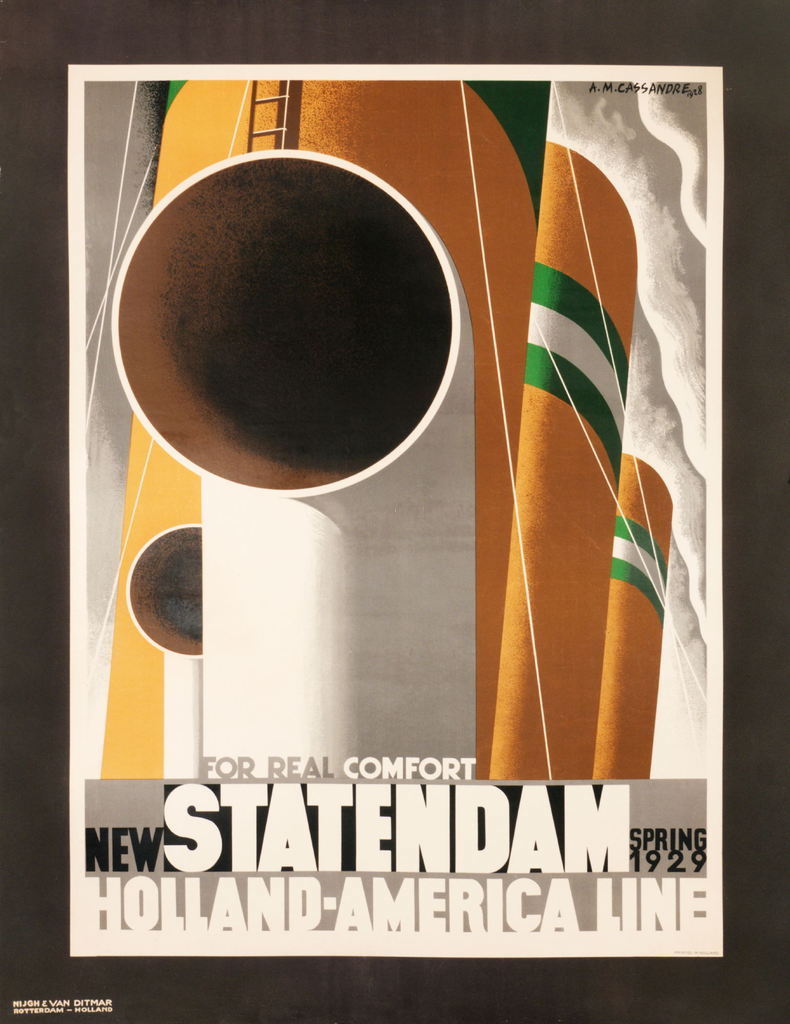MARIANI’S
Virtual Gourmet
February 1, 2015
NEWSLETTER
Cruise Poster, 1929
IN THIS ISSUE
PHILADELPHIA LOSES THE FOUNTAIN
By Brian Freedman
NEW YORK CORNER
CAFFÈ DEI FIORI
By John Mariani
NOTES FROM THE WINE CELLAR
THE WORLDWIDE MARKET FOR WINE
AND SPIRITS LOOKS . . . TENTATIVE
By John Mariani
❖❖❖
GOODBYE TO ALL THAT:
PHILADELPHIA LOSES THE FOUNTAIN
By Brian Freedman
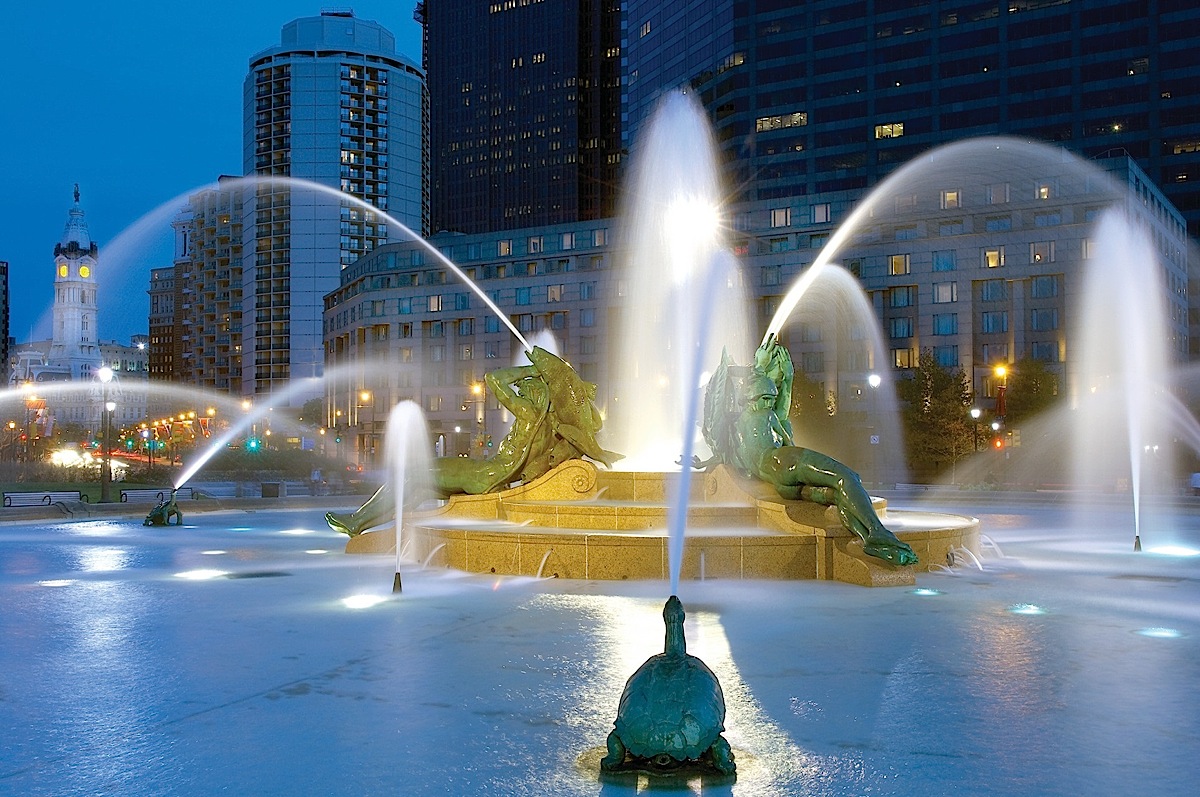
The Swann Fountain, Philadelphia
The first time an editor
instructed me to visit the Fountain Restaurant at
the Four Seasons Hotel Philadelphia to write a
review, I was absolutely terrified. It was only a
few years into my career as a writer, and, as a
20-something kid still shocked to have the
opportunity to pay even some of my bills
doing what amounted to a dream job, I was overcome
with nerves. This was the Fountain, named after
the beautiful Swann Fountain (above)
outside its windows, one of precious few
fine-dining destinations in my hometown, and a
restaurant cloaked in legend.
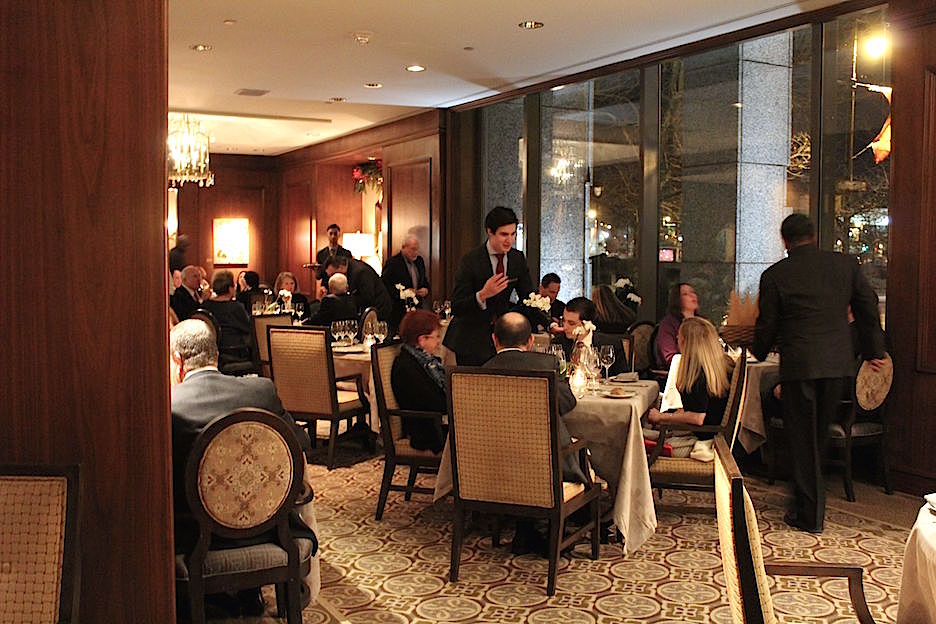 What business did I have passing
judgment on the place?
What business did I have passing
judgment on the place?
To this day, I distinctly
remember my hands shaking ever so slightly as I
knotted my tie that night in the mirror. Since 1983,
it had been among the standard-setters for what a
restaurant could be not just in Philadelphia but far
beyond. I’d been hearing about it my entire
life.
We drove up to the Four Seasons
Hotel from our place on Washington Square, found
parking down the street because we couldn’t afford
the valet fee on a young writer’s pay, and walked
through the shimmering lobby, past the Swann Lounge
with its fireplace and bar scene like something out
of a Fitzgerald novel, and toward the Fountain,
where we were immediately put not just at ease, but
at leisure.
I’d always imagined that the room
would be stuffy, a pressure-cooker of dining
protocol and etiquette obscure enough to put Emily
Post on her guard. What I found instead was the
telltale hum of people thoroughly at ease while in
the care of one of the finest, most professional
staffs in America. That was the first of what would
be many lessons that night: Fine dining isn’t just
about the food and the beauty of the room; it’s also
predicated on the kind of service that allows those
fortunate enough to experience it to shed pretense
and stress and simply, thoroughly, sink into the
moment and enjoy themselves.
That dinner
took place eight years ago, and since then, I’ve had
the great good fortune to dine there many times,
under the care of multiple executive chefs,
sommeliers, maȋtre d’s, and more. And throughout it
all, the Fountain has maintained its place as one of
a fraternity of restaurants that, though we don’t
have Michelin Guide rankings in Philadelphia, embody
the perfectly concise definition of a coveted
three-star spot: one worth a special journey to get
there, no matter where you’re coming from.
In the years since that first
dinner, I have been lucky enough to develop a
professional relationship with The Fountain in 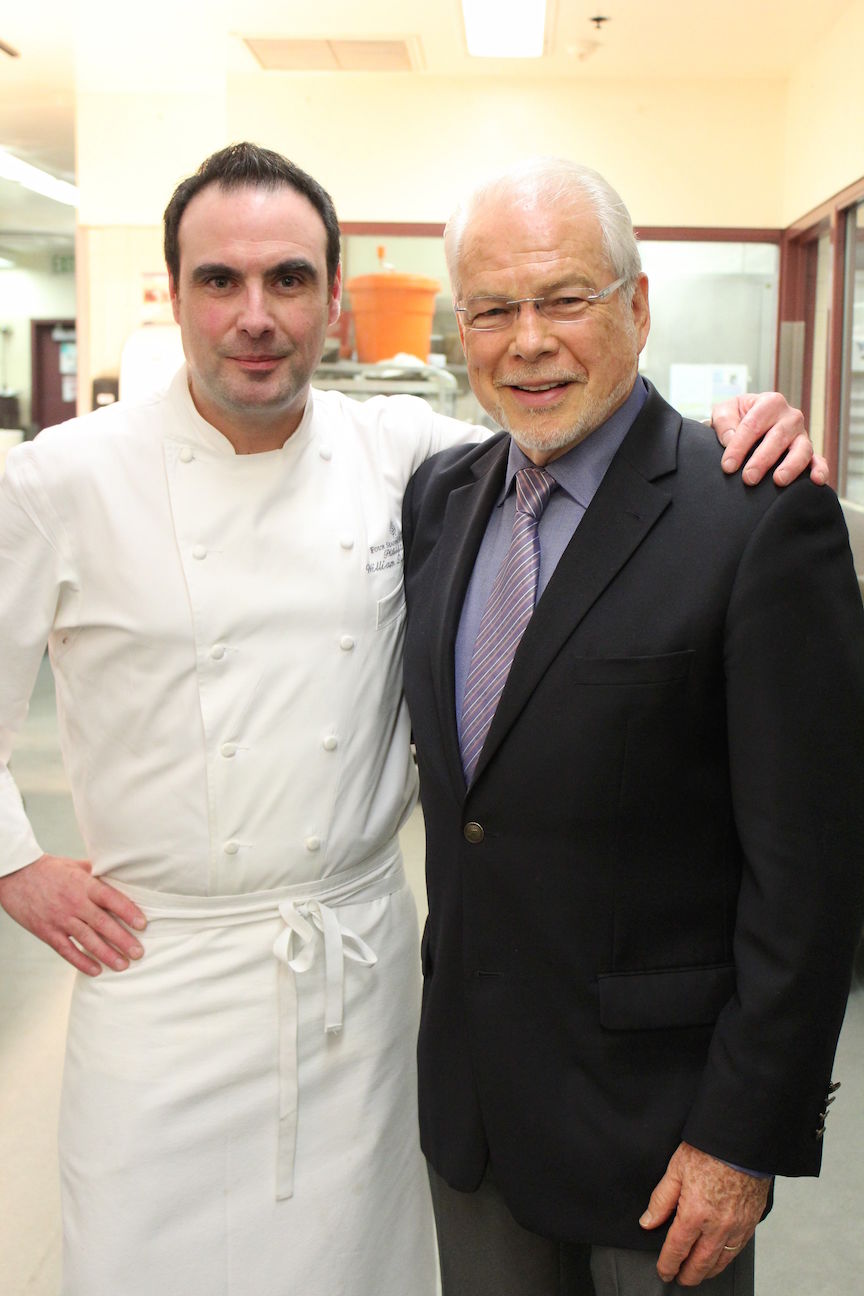 particular and the Four Seasons Hotel
Philadelphia in general, hosting occasional tastings
over the years, running seminars, covering special
wine dinners and menus, and more. All of which meant
that I could no longer review them—my objectivity
would of course be questioned if I did—but the
experience of having had the privilege of working
with such a stellar team, within such hallowed
halls, was worth that minor price. The Fountain’s
staff, both front and back of the house, was among
the most dedicated I’ve ever had the pleasure to
know.
particular and the Four Seasons Hotel
Philadelphia in general, hosting occasional tastings
over the years, running seminars, covering special
wine dinners and menus, and more. All of which meant
that I could no longer review them—my objectivity
would of course be questioned if I did—but the
experience of having had the privilege of working
with such a stellar team, within such hallowed
halls, was worth that minor price. The Fountain’s
staff, both front and back of the house, was among
the most dedicated I’ve ever had the pleasure to
know.
It’s been fascinating and deeply
rewarding to follow the evolution of the Fountain
over the years. Under the leadership of world-class
chefs like Jean-Marie Lacroix and William DiStefano (right), Martin Hamann, Rafael
Gonzalez, David Jansen and , the cuisine here has
changed, yes, but it’s never sacrificed quality
throughout its
evolution. The kitchen staff is among the
best in the business, executing dish after dish with
impeccable precision night after night. Actually,
more than precision: What’s always struck me over
the years is the pure joy embodied in the food, the
unexpected flourishes and generous touches that have
infused preparations both familiar and surprising
with an electric sense of joy, of life.
These meals were always
accompanied by service as well-choreographed as the
Ballets Russes yet always with a smile and a
personal touch that kept it more than accessible.
And wines, regardless of what you wanted to spend,
were impeccably paired. Whether it was Scott
Turnbull, Philip Clough, Kyle Trebilcock, Denis
Espina, Stephen Flis, or any of the other top-notch
sommeliers, beverage directors, managers or servers
taking care of you, your glass was always full in
every sense of the phrase.
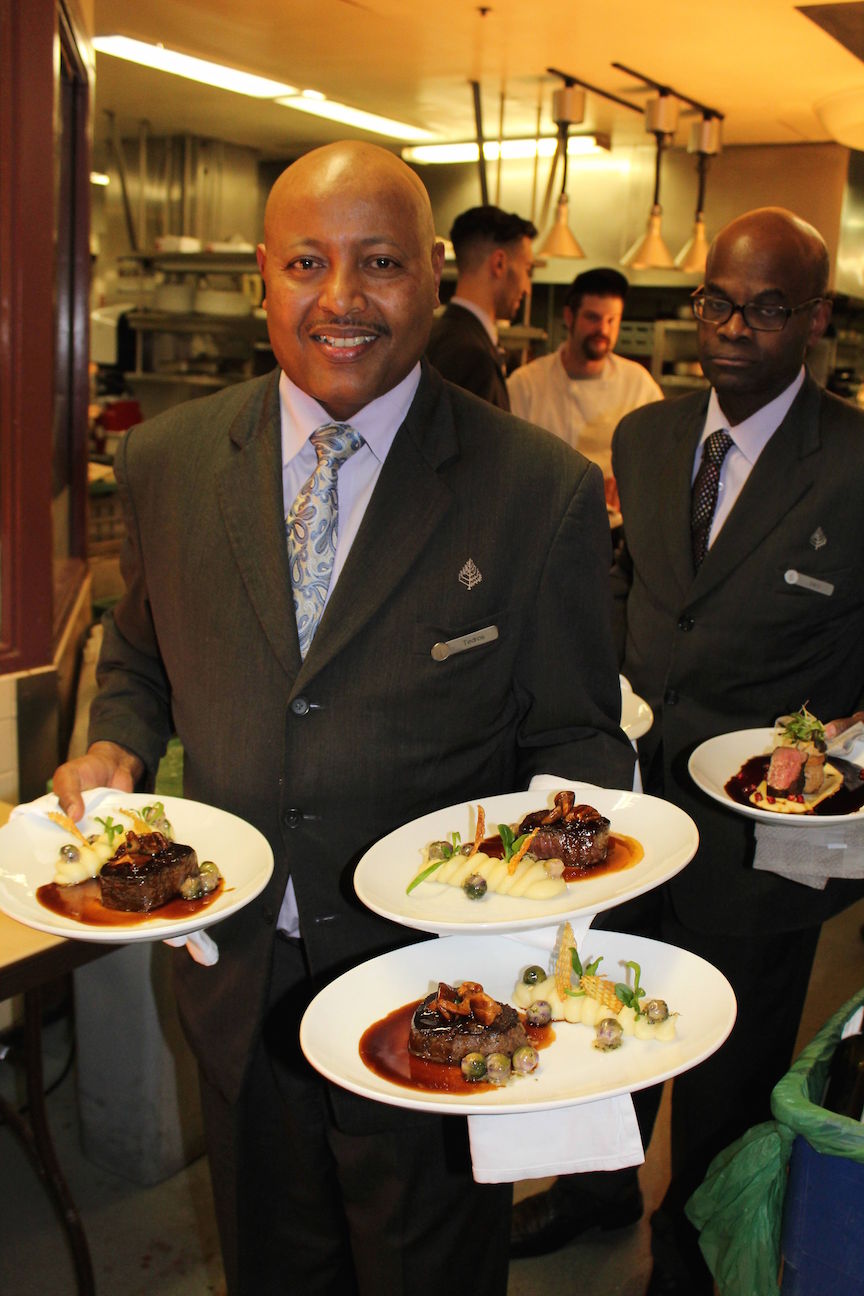 Back in
November, it was announced that The Fountain would
serve its final dinner on December 27th last year.
(It remains open for breakfast and lunch, and is
available in the evenings for private events; all of
this will remain the case until Sage Hospitality
takes over the hotel in June. At some point after
that, the space where the Fountain is now will turn
into a new restaurant, Urban Farmer.)
Back in
November, it was announced that The Fountain would
serve its final dinner on December 27th last year.
(It remains open for breakfast and lunch, and is
available in the evenings for private events; all of
this will remain the case until Sage Hospitality
takes over the hotel in June. At some point after
that, the space where the Fountain is now will turn
into a new restaurant, Urban Farmer.)
The reservation book immediately began to
fill up with guests from Philadelphia and far
beyond. With the help of the amazing team there, my
wife and I secured a reservation for December 17th.
It was among the most memorable meals of my life, a
tour of everything that has always made The Fountain
such a standout: technically impeccable yet deeply
heartfelt preparations, stunning service, amazing
wine, and a sense of coming home.
That’s a feeling I never could
have imagined having as I knotted my tie with shaky
hands all those years ago, but there it was: what
had, back then, seemed like a dizzyingly high level
of the dining firmament had, from the moment we
walked into the room that night, disarmed me with
its sheer friendliness and comfort. And now, eight
years later for me and 31 years later for its most
devoted guests, it has served it final dinner
service.
So The Fountain restaurant is
gone, though the Swann Fountain remains. But its
impact on the city will continue to live on: No
restaurant that has existed at the top of its own
lofty game for three decades is ever forgotten. And
so many of the people that have worked there over
years have and continue to shape Philadelphia’s
dining life. That dining life is, of course, an
always-changing thing. And whereas many of the
classic fine-dining establishments of the past have
taken their collective place in the annals of the
culinary life of Philadelphia, their influence is
still felt. Many of our current constellation of
star chefs worked in the kitchens of these legends,
as did countless restaurateurs, beverage
professionals, servers, and more. So while
establishments like the Fountain Restaurant, 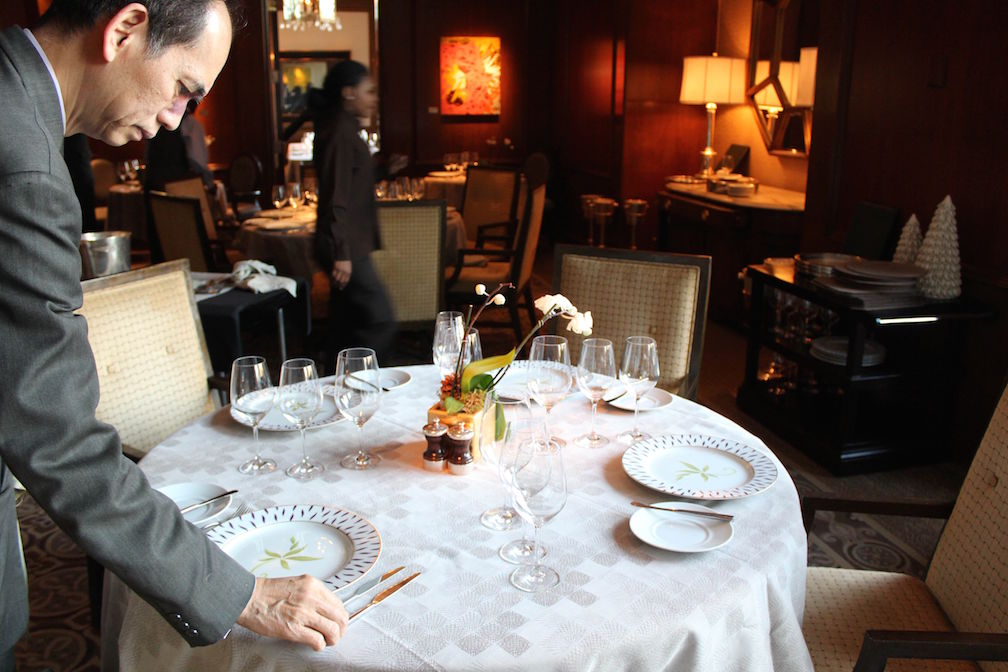 Le Bec-Fin, Déjà-Vu, Deux Cheminées,
La Truffe and Il Gallo Nero, are gone,
they still, in a very real way, exert an influence
on our dining life here, despite the more casual—yet
elegant—nature that so many of our top restaurants
embody.
Le Bec-Fin, Déjà-Vu, Deux Cheminées,
La Truffe and Il Gallo Nero, are gone,
they still, in a very real way, exert an influence
on our dining life here, despite the more casual—yet
elegant—nature that so many of our top restaurants
embody.
Much has been made of the demise
of that style of fine dining in Philadelphia.
(Lacroix at the Rittenhouse Hotel remains but
nothing else joins it in the genre as of now and
none on the horizon.) Theories abound as to why—it’s
not how we tend to eat anymore, the younger
generation tends to shy away from longer meals, and
more—but the truth is that no one really knows with
certainty the reason for the change. I feel that
many chefs feel as if they can craft food at a
dazzlingly high level without all the accouterments
of classic fine dining. Our best restaurants
certainly prove that point—there are countless ones
here, no doubt—but I’ve always believed that a major
city  can support both: they
need not be mutually exclusive. That is
certainly still the case in New York, Chicago,
Boston, Washington, New Orleans and the major cities
in the west.
can support both: they
need not be mutually exclusive. That is
certainly still the case in New York, Chicago,
Boston, Washington, New Orleans and the major cities
in the west.
Regardless, food of stunning
complexity and bracing originality is available all
over Philadelphia, from
chefs who have worked in the fabled fine-dining
kitchens of the past as well as those who have come
up through other roads. Philly is genuinely one of
the most exciting restaurant cities in the country
right now. Everyone, however, seems to agree that
the final dinner service at The Fountain has marked
the end of an era. Which, indeed, it does.
As for me, I owe a huge debt of
gratitude to everyone at the Fountain Restaurant
that I’ve been fortunate enough to know and work
with, and alongside whom I have had the chance to
celebrate anniversaries, birthdays, and more over
the years. So much of my own understanding of what
fine dining can achieve, and why it’s so important
to a city, is thanks to them. I have a feeling that
that’s the case for everyone that’s been lucky
enough to dine there.
❖❖❖
By John Mariani
 Caffè
dei Fiori
Caffè
dei Fiori 973 Lexington Avenue (near 71st Street)
caffedeifiorinewyork.com
Those downtowners and
Brooklynites who enjoy dissing the restaurants on
the Upper East Side of Manhattan have obviously
never dined at Le Cirque, Daniel, Café Boulud,
JoJo, The Mark, Orsay and other first-rate
restaurants in that stretch of territory—and those
are just the French brigade. Fine Italian
restaurants also abound—Sandro’s, Sistina,
Caravaggio, Saint Ambroeus, Petaluma, and, now,
Caffé dei Fiori, recently opened by Daliso Gulmini
and Andrea Nanni in a former three-level antiques
store.
It’s a quirky lay-out, with a main dining
room down a few steps, a wrought iron banister
that leads to a tiny landing, and an intimate
third level for a few tables, all with intensely
colorful flowers and tablecloths, overlooking the
Avenue. The
chairs are beautifully upholstered. The façade’s
window has a gaiety about it that draws you in
from the street, where the owners graciously
receive you and welcome you to their little labor
of love.
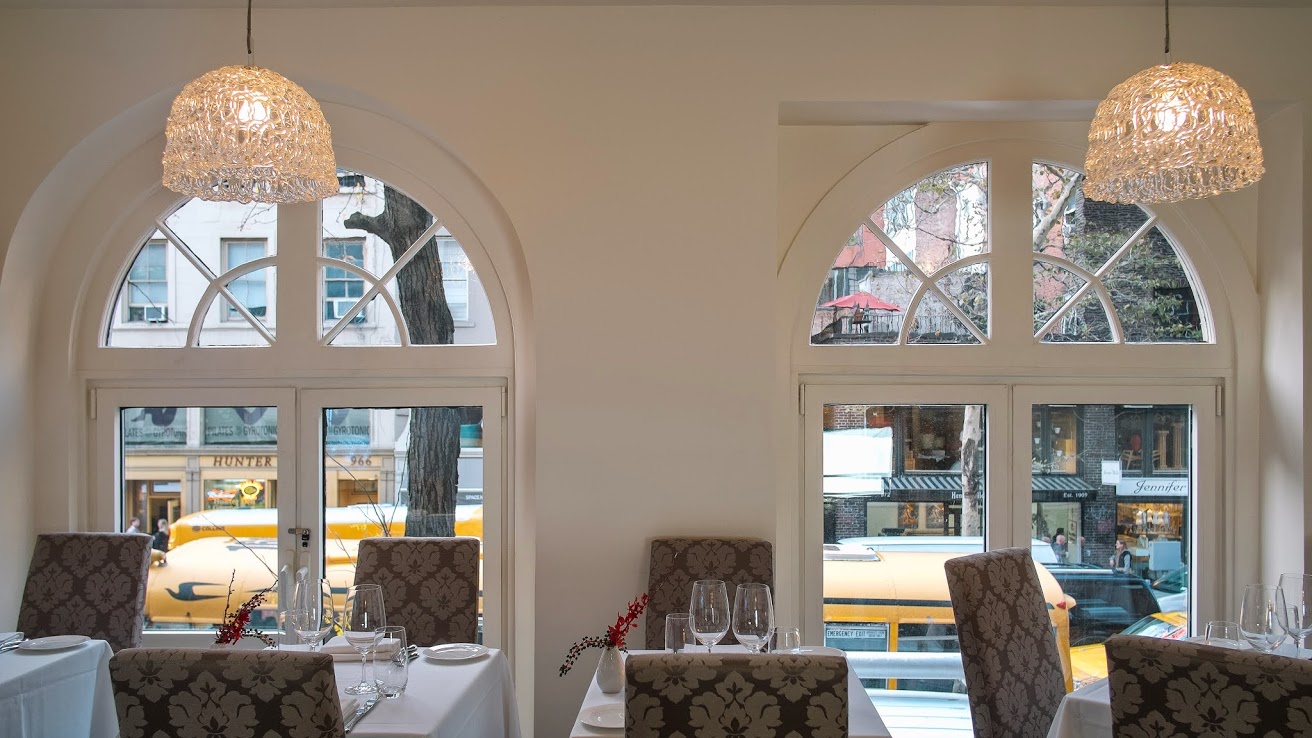 Chef
Giovanni Tenace is from Puglia, with long
experience in Italy, London and Sydney, before he
came to NYC to run his own pasta manufacturing
company, and his knowledge of the process shows in
some of the most delicate pastas around town.
Chef
Giovanni Tenace is from Puglia, with long
experience in Italy, London and Sydney, before he
came to NYC to run his own pasta manufacturing
company, and his knowledge of the process shows in
some of the most delicate pastas around town.
Indeed, the pastas are where you’ll find
dishes you will not elsewhere. Most of
the rest of the menu toes a fairly standard line
of New York-Italian favorites, including several
dishes with salmon, which Italians rarely eat but
which every chef in the city must have on the
menu. The
carpaccio of salmon with orange and fennel ($22)
is, however, delicious, the flavor of the salmon
light. Beef
carpaccio ($22) is equally finessed, with a touch
of Dijon mustard, Parmigiano, greens and the nice
touch of almonds.
Grilled octopus ($20)
took on added flavors of eggplant, basil,
Parmigiano and tomato sauce, while an unusual
tartare of ricciola
(amberjack) took on the richness of a vegetable brunoise
and a little soy sauce ($23).
So,
on to Mr. Tenace’s pastas, which include
first-rate risotti,
one done with baby artichoke hearts and prawns
($28), another with black or white truffles
(market price).
Splendidly hearty for this winter is a dish
of egg ravioli (below)
with braised duck in a reduction of its juices
($26, full portion), as well as an egg-rich
housemade tagliatelle
with beef ragù
($27). Plump
tortelloni
($22) are stuffed with buffalo milk cheese 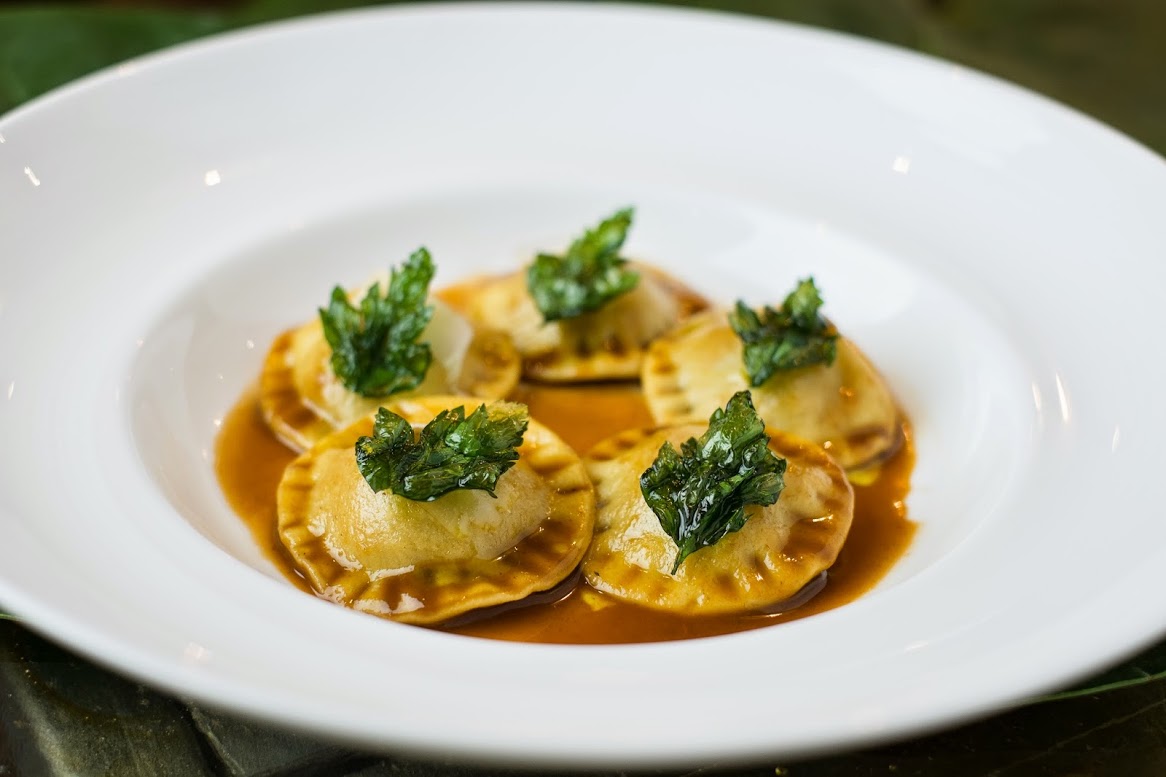 ricotta and cavolo nero
(kale).
ricotta and cavolo nero
(kale).
Though very pricey at $64, the Dover
sole cooked in butter was wholly rewarding and so
rich you might consider sharing one after the
pastas. Branzino
($38) is poached gently with herbs and emerges
delicately flavorful. A veal chop alla
Milanese ($40) is as good as others around
town, but more out of the ordinary is a terrine of
chicken wrapped
in prosciutto, leeks and fontina cheese ($26).
The
lamb chops listed are from New Zealand, therefore
most probably frozen, which is off-putting from
the quality of everything else.
Desserts are well worth
ordering, notably a satiny pear tart with sorbet
($12) and a mousse of bitter chocolate with
whipped cream ($12).
The wine list at Caffé dei
Fiori is substantial and well priced in every
category.
By the way, though I have not
tried it, the brunch menu offers a number of
dishes not found everywhere else, including crêpes
with tomato sauce, mushrooms, and prosciutto
($20), a frittata of zucchini with taleggio cheese
($18), and tiny meatballs of pork with grilled
potato scones ($18).
Caffé dei Fiori is a
charming new addition to the Upper East Side,
already winning the neighborhood crowd but
deserving of a visit from all those who so rarely
venture north of 42nd
Street.
Caffé dei Fiori is open
for lunch Mon.-Fri. dinner nightly, brunch on
weekends
By John Mariani
THE WORLDWIDE
MARKET FOR
WINE AND SPIRITS LOOKS . . . TENTATIVE
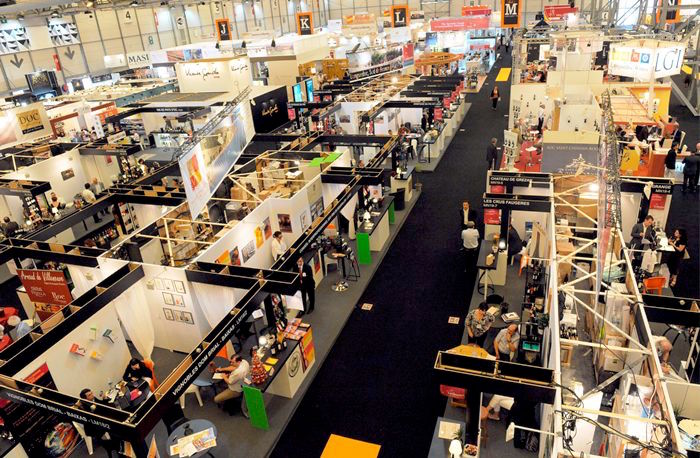 These are neither
the best of times nor worst of times for the
global wine and spirits markets, but it is a
time of uncertainty about the economy, politics
and societal changes that make predictions about
the future more difficult than it’s been in a
long time.
These are neither
the best of times nor worst of times for the
global wine and spirits markets, but it is a
time of uncertainty about the economy, politics
and societal changes that make predictions about
the future more difficult than it’s been in a
long time.
For while the 1980s and 1990s
were a period of soaring expectations—and not a
little hype—it did seem the whole world was
becoming more interested and could better afford
to buy more wine and spirits than at any time in
history. Then
came 9/11, the debacle of 2008, the economic
collapse of Greece, Ireland and Spain, and
increasing terrorism in major cities.
To an extent, wine and spirits
sales overall are still rising, but the future is
anything but certain. Vodka still dominates
spirits sales, and whiskies
and bourbons are projected to rise 8.8% and 19.3%,
respectively, over the next five years. These
and a great deal more data have just been released
by the IWSR,
a forty-year old marketing company that tracks
brand performance in 125
countries across the world using local market
input from distributors, importers, producers,
retailers, duty-free and gray operators in each
country.
and whiskies
and bourbons are projected to rise 8.8% and 19.3%,
respectively, over the next five years. These
and a great deal more data have just been released
by the IWSR,
a forty-year old marketing company that tracks
brand performance in 125
countries across the world using local market
input from distributors, importers, producers,
retailers, duty-free and gray operators in each
country.
To find out the effects of all
these data, I had a conversation by phone with
Guillaume Deglise (right), CEO of Vinexpo,
the trade show (above)
to be held in the city of Bordeaux this June,
which commissioned the IWSR report, to ask which
and how forces will drive the market in 2015 and
beyond.
Q. Your
new report makes much of the impact of the Asian
market on global sales, but there is also some
caution in it.
A. While 2013's growth in the
region has been curtailed by the Chinese
government’s anti-corruption legislation,
five-year forecasts remain positive at about 3.5%
growth. Cognac and Armagnac have found new markets
in Asia, and sales rocketed by 19% from 2009-12 and are
expected to grow annually at a 3% rate. Right
now Asia-Pacific accounts for 63% of the world’s
total spirits consumption.
Q.
Which categories are showing the most growth in
spirits?
A.
Premium whiskies and Kentucky bourbons are back in
vogue, with Russia, Brazil, Mexico, India and
Poland driving forces outside of the U.S. Vodka is
still number one in sales but that’s leveling out
now. Baiju,
a spirit like vodka made and mostly consumed in
China, is the number one best seller of all.
Q. Are
the current sanctions against Russia and falling
oil prices going to hurt the Russian market?
A.
Russia is difficult to predict. Vodka is still the
best-selling spirit there, but the younger
generation does not want to pursue the same habits
of their elders. They are much more open to
spirits from outside Russia.
Q.
What about the weakening of the euro? How will
that affect global sales of European wines and
spirits?
A. The
industry has, as a result of the stronger dollar,
become much more competitive
than in the past. A strong dollar translates to
lower prices for French, Italian and Spanish wines
and spirits, which offers clear advantages on the
international scene. I don’t think export will be
much affected through 2016 but that depends on the
future value of the euro.
Q. Do
you think some producers in Europe will try to
make up for the falling price of the euro by
hiking their own prices?
A. It will
depend on the price category of each wine and on
the stocks available. If there is a lot of stock,
they won’t push prices up; they’ll look to improve
their margins instead. Remember, the U.S. is still
the largest consumer of wines and spirits in the
world. Some producers of very high-end, rare wines
and spirits may raise their prices.
Q.
What about sparkling wines?
A.
Sparkling wines (excluding Champagne) accounted
for 8% of the world’s wine consumption – and are
expected to rise to 8.9% by 2018. Spanish
cava sales, spurred
by growth in imports to Belgium, Nigeria and
France, escalated by more than 100,000 cases in
2013. In
that same year Italian
prosecco sales doubled.
Q. Has
this hurt Champagne sales?
A.
I used to work for Champagne, so I know it well,
and consumption has dipped—1.4% globally in 2013--
as consumers everywhere look to cheaper
alternatives like prosecco and cava. Outside
of France, Champagne is perceived as very high
priced, only for special occasions, but I believe
it still has a quality that cannot be matched, and
grape prices in Champagne are very high. Even
though French consumption is down, they continue
to drink Champagne because they have access to
many more inexpensive labels. Champagne
sales are increasing, however, in the U.K, U.S,
Australia and Japan.
Q.
What about wine consumption?
A.
Red wine continues to dominate, representing 54.8%
of all still wine consumed in 2013. Reduced
demand, primarily in China—where more than 90% of
wine consumed is red--drove worldwide consumption
down by 19.8 million cases. Rosé
sales are going up nicely, by about 9%.
Q.
Recent reports indicate that the business lunch
has not only declined in importance because have
so little time and are forced to eat at their
desk, but that when they do dine out they order
less and cheaper wines. Do
you see that in France, too?
A.
Oh, yes, there is a big change in consumption
patterns everywhere. Business people don’t take as
much time to enjoy lunch, and they drink less,
though they drink better wines. Not the
high-end labels, however, because the executives
cannot be seen showing off to their clients the
way they once did. Expense accounts have been cut
and, as you know, we are still in a deep economic
crisis in Europe.
A.
Yes, the younger generation, especially in France,
is spending more time in wine bars and bistros.
The sales are now being driven by them.
❖❖❖
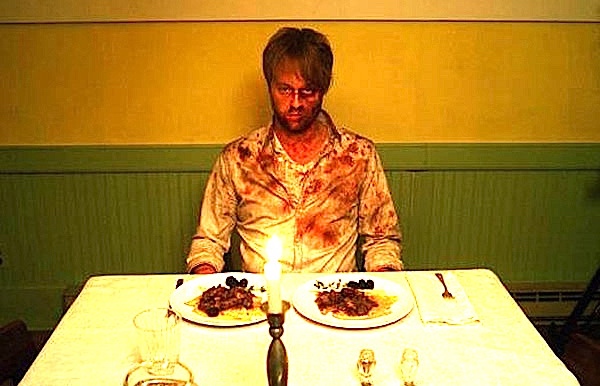
After two Phoenix
police officers responded to a call from a
restaurant about a non-paying customer, the
officers "concluded the man had some type of
mental health issue" and paid the check on his behalf so
he would avoid arrest and jail time. They then took
suspect Mykel Cantrel Cooper to a mental health
facility, where he allegedly hinted that he "did
something bad" to his roommate. Police followed up and
discovered the dead body of Cooper's roommate in their
apartment. Cooper was thereupon charged with
first-degree murder.
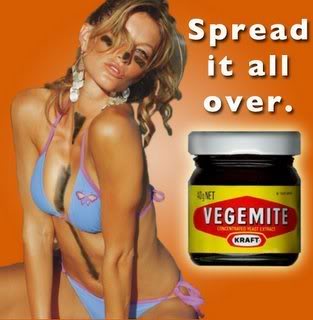
YOUR HONOR, WHAT WOULD YOU THINK OF "VEGEMITE"?
A judge in Valencienne, France, denied a couple the right to name their daughter "Nutella" because it would invite "mockery or disobliging remarks."
Any of John Mariani's books below may be ordered from amazon.com.
 I'm proud and happy to announce that my
new book, The Hound
in Heaven (21st Century Lion Books), has just
been published through Amazon and Kindle.
I'm proud and happy to announce that my
new book, The Hound
in Heaven (21st Century Lion Books), has just
been published through Amazon and Kindle. It is a novella, and for anyone who loves dogs, Christmas, romance, inspiration, even the supernatural, I hope you'll find this to be a treasured favorite. The story concerns how, after a New England teacher, his wife and their two daughters adopt a stray puppy found in their barn in northern Maine, their lives seem full of promise. But when tragedy strikes, their wonderful dog Lazarus and the spirit of Christmas are the only things that may bring back his master back from the edge of despair.
WATCH THE VIDEO!
“What a huge surprise turn this story took! I was completely stunned! I truly enjoyed this book and its message.” – Actress Ali MacGraw
“He had me at Page One. The amount of heart, human insight, soul searching, and deft literary strength that John Mariani pours into this airtight novella is vertigo-inducing. Perhaps ‘wow’ would be the best comment.” – James Dalessandro, author of Bohemian Heart and 1906.
“John Mariani’s Hound in Heaven starts with a well-painted portrayal of an American family, along with the requisite dog. A surprise event flips the action of the novel and captures us for a voyage leading to a hopeful and heart-warming message. A page turning, one sitting read, it’s the perfect antidote for the winter and promotion of holiday celebration.” – Ann Pearlman, author of The Christmas Cookie Club and A Gift for my Sister.
“John Mariani’s concise, achingly beautiful novella pulls a literary rabbit out of a hat – a mash-up of the cosmic and the intimate, the tragic and the heart-warming – a Christmas tale for all ages, and all faiths. Read it to your children, read it to yourself… but read it. Early and often. Highly recommended.” – Jay Bonansinga, New York Times bestselling author of Pinkerton’s War, The Sinking of The Eastland, and The Walking Dead: The Road To Woodbury.
“Amazing things happen when you open your heart to an animal. The Hound in Heaven delivers a powerful story of healing that is forged in the spiritual relationship between a man and his best friend. The book brings a message of hope that can enrich our images of family, love, and loss.” – Dr. Barbara Royal, author of The Royal Treatment.
The Encyclopedia of American Food and Drink by John F. Mariani (Bloomsbury USA, $35) Modesty forbids me to praise my own new book, but let me proudly say that it is an extensive revision of the 4th edition that appeared more than a decade ago, before locavores, molecular cuisine, modernist cuisine, the Food Network and so much more, now included. Word origins have been completely updated, as have per capita consumption and production stats. Most important, for the first time since publication in the 1980s, the book includes more than 100 biographies of Americans who have changed the way we cook, eat and drink -- from Fannie Farmer and Julia Child to Robert Mondavi and Thomas Keller. "This book is amazing! It has entries for everything from `abalone' to `zwieback,' plus more than 500 recipes for classic American dishes and drinks."--Devra First, The Boston Globe. "Much needed in any kitchen library."--Bon Appetit. |
"Eating Italian will never be the same after reading John Mariani's entertaining and savory gastronomical history of the cuisine of Italy and how it won over appetites worldwide. . . . This book is such a tasteful narrative that it will literally make you hungry for Italian food and arouse your appetite for gastronomical history."--Don Oldenburg, USA Today. "Italian
restaurants--some good, some glitzy--far
outnumber their French rivals. Many of
these establishments are zestfully described
in How Italian Food Conquered the World, an
entertaining and fact-filled chronicle by
food-and-wine correspondent John F.
Mariani."--Aram Bakshian Jr., Wall Street
Journal.
"Equal parts
history, sociology, gastronomy, and just
plain fun, How Italian Food Conquered the
World tells the captivating and delicious
story of the (let's face it) everybody's
favorite cuisine with clarity, verve and
more than one surprise."--Colman Andrews,
editorial director of The Daily
Meal.com. "A fantastic and fascinating
read, covering everything from the influence
of Venice's spice trade to the impact of
Italian immigrants in America and the
evolution of alta cucina. This book will
serve as a terrific resource to anyone
interested in the real story of Italian
food."--Mary Ann Esposito, host of PBS-TV's
Ciao
Italia. "John Mariani has written the
definitive history of how Italians won their
way into our hearts, minds, and
stomachs. It's a story of pleasure over
pomp and taste over technique."--Danny Meyer,
owner of NYC restaurants Union Square
Cafe, The Modern, and Maialino.
|
 |
 |
 |
 |
 |
 |
 |
 |
 Everett Potter's Travel Report:
Everett Potter's Travel Report: 
 Eating Las Vegas
is the new on-line site for Virtual Gourmet
contributor John A. Curtas., who since 1995
has been commenting on the Las Vegas food
scene and reviewing restaurants for Nevada
Public Radio. He is also the
restaurant critic for KLAS TV, Channel 8 in
Las Vegas, and his past reviews can be
accessed at KNPR.org.
Click on the logo below to go directly to
his site.
Eating Las Vegas
is the new on-line site for Virtual Gourmet
contributor John A. Curtas., who since 1995
has been commenting on the Las Vegas food
scene and reviewing restaurants for Nevada
Public Radio. He is also the
restaurant critic for KLAS TV, Channel 8 in
Las Vegas, and his past reviews can be
accessed at KNPR.org.
Click on the logo below to go directly to
his site.

Tennis Resorts Online: A Critical Guide to the World's Best Tennis Resorts and Tennis Camps, published by ROGER COX, who has spent more than two decades writing about tennis travel, including a 17-year stretch for Tennis magazine. He has also written for Arthur Frommer's Budget Travel, New York Magazine, Travel & Leisure, Esquire, Money, USTA Magazine, Men's Journal, and The Robb Report. He has authored two books-The World's Best Tennis Vacations (Stephen Greene Press/Viking Penguin, 1990) and The Best Places to Stay in the Rockies (Houghton Mifflin, 1992 & 1994), and the Melbourne (Australia) chapter to the Wall Street Journal Business Guide to Cities of the Pacific Rim (Fodor's Travel Guides, 1991).


MARIANI'S VIRTUAL GOURMET
NEWSLETTER is published weekly. Editor/Publisher: John
Mariani.
Editor: Walter Bagley. Contributing Writers: Christopher Mariani,
Robert Mariani, Misha
Mariani,
John A. Curtas, Edward Brivio, Mort Hochstein,
Andrew Chalk, Dotty Griffith and Brian Freedman. Contributing
Photographers: Galina Dargery, Bobby
Pirillo. Technical Advisor: Gerry McLoughlin.
To un-subscribe from this newsletter,click here.
© copyright John Mariani 2015
